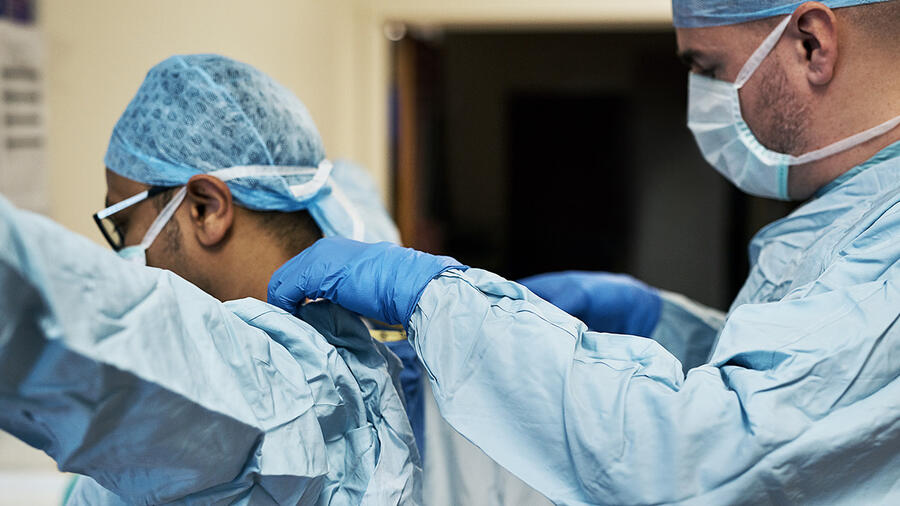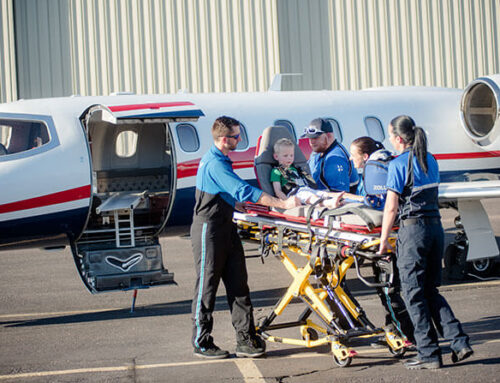ACE Air and Ambulance, Fox Flight Air Ambulance and AirCARE1 told ITIJ how they managed to keep their crews safe during the height of the pandemic – and beyond
ACE Air and Ambulance
On 5 March 2020, the first Covid case in southern Africa was identified in South Africa: a male citizen returning from a stay in Italy. As an air and ground ambulance service, ACE had been monitoring the goings on in Europe and the US.
Dr Charles Crawshaw, ACE Air and Ambulance Chief Medical Director, tells ITIJ: “It was clear that there was going to be a need for us to ensure a reliable supply of Personal Protective Equipment (PPE), which we quickly did. Of greater concern was the dire need for ventilators. At the time, there were estimated to be 20 ventilators for Zimbabwe’s 14 million population. Five of these ventilators were owned by ACE!”
The world stock of ventilators had very rapidly been bought up by cash-rich countries and it was clear that there was going to be a need for the company to be prepared to medevac critical cases to countries with spare ventilators and intensive treatment unit capacity.
ACE’s core business is flying critically ill patients from countries where there are limited medical facilities to South Africa for a higher level of care. “The restrictions imposed by South Africa meant that initially we were restricted to flying South African nationals who were non-Covid cases,” says Crawsjaw. “We were also restricted in which airports we could use. We could not follow our usual policy of providing a bed-to-bed service but were required to hand over to the airport ambulance service on the apron.”
ACE put protocols in place to protect its ground ambulance crews, who were required to transport Covid positive patients. This included staff undertaking a two-week stint, during which time they ‘lived in’ at the base. This was to avoid the risk of infection on public transport. Protocols covered screening of all patients, a checklist of all the PPE to be carried, and decontamination and cleaning of vehicles. The entire staff was trained on the proper use of PPE and the disposal of contaminated PPE.
Lockdown was strictly applied in Zimbabwe. By mid-July, over 105,000 Zimbabweans had been arrested or fined for breach of the rules. July also saw South Africa’s first major spike of cases. Zimbabwe’s outbreaks usually lagged three weeks behind South Africa.
After this spike, there was a relaxation of travel restrictions. ACE was now allowed, on a case-by-case basis, to fly patients from any nationality to South Africa, although this had to be done through diplomatic channels. This created a further delay for critical cases, with the team depending on diplomats to decide whether a case was urgent or not.
It was becoming increasingly clear from the huge volume of published research that the risk of infection was greatest in the two days before symptoms developed and the subsequent three to five days.
“These findings, along with the knowledge that our ground crew had successfully transported a large number of Covid-positive patients without any of them becoming infected, made us confident that we could safely transport the critically ill Covid cases,” says Crawshaw. ACE produced protocols that covered both pilots and medical crew. This ensured that the pilots were in the cockpit with the door closed prior to loading the patient, and they remained in the cockpit until the cabin had been vacated and cleaned. The pilots were trained in the use of PPE and the medical crew had to undertake the passenger briefing normally undertaken by one of the pilots.
Crawshaw tells ITIJ: “I gave a Power Point presentation on the science that supported our decision. This was well received, although there was the inevitable suggestion by some pilots that they thought that wearing an N95 mask would prevent them from communicating with air traffic control, and also that they might become hypoxic and be unable to fly! I pointed out that I had been wearing a surgical mask for a large proportion of my working life and asked if any of them thought I had suffered brain damage? There were no takers.”
At the peak of the epidemic in Zimbabwe, ACE was transporting Covid patients from across southern Africa. At times, the lack of bed availability in Johannesburg meant that the service had to look for beds in other cities in South Africa. Sometimes, Kenya was the nearest available bed and even on one occasion, Italy.
“Since we began to carry Covid patients,” Crawshaw says, “we have not had one member of the crew come down with Covid. We rapidly realised that using the isolation pod was impractical in the confines of a cabin, particularly with respiratory patients.”
Fox Flight Air Ambulance
David Fox, President of Fox Flight Air Ambulance, tells ITIJ: “Most providers would have had protocols in place already for infectious disease transports when the pandemic started. We were somewhat fortunate because Toronto, where we’re based, was one of the global hot spots during the SARS epidemic 18 years ago.
“So, we lived through something similar before – although not nearly as bad of course – and had that experience. We already had rigorous protocols documented and systems in place that allowed us to respond quickly. We also took steps to stockpile and source PPE and essential equipment in the early days of the pandemic because we had some idea of how it was going to go.”
Fox Flight’s Medical Director is a military physician who was with the Canadian Armed Forces serving in Sierra Leone during the Ebola outbreak. Thanks to his training and experience, he was able to put a very strong infectious disease training regimen in place, says Fox.
In terms of practical steps for staff moving Covid patients, Fox Flight used full body HAZMAT suits with the Versaflo breathing apparatus for the medical team. For the aircrew, the service uses respirator masks and medical gowns, and has a process in place for donning and removing PPE before and after loading and unloading the patient.
The Covid patients Fox Flight has moved have been fully vented, so they are on a closed breathing system. Any air from the patient passes through two viral bacteria filters in line in the system, so they know that 99.98 per cent of viral bacterial is removed. Once the flight is completed, the interior is wiped down with antibacterial wipes, and then the team uses a Sani-Swiss system to fog the cabin and kill off any bacteria that might remain before the next mission. The Sani-Swiss also travels with the crew so they can fog the plane after the patient is dropped off.
“The infectious disease protocols were already in place; we just enhanced some of them to be more Covid specific,” Fox says. “After about five weeks into the official pandemic, about mid-April 2020, we were lucky enough to have the ability to test both patients and staff members for Covid ourselves. That was vital, because we were travelling a lot internationally at the time, bringing people home, so our crews had to be tested going over and coming back for each mission. It was a challenging environment to do what we do.”
When the pandemic started, Canada put policies in place – and some of those are still in place – that restricted where Fox Flight was allowed to go, what its flight and medical crews were allowed to do when outside the country, and how they were allowed to do their job. Fox says his crews weren’t allowed to go in public spaces in foreign countries, they weren’t allowed to leave the airport in some cases, they couldn’t ride on public transit, they couldn’t go to restaurants or stay overnight in hotels in some places.
“When we would pick up a patient, sometimes we were allowed to go to the hospital and sometimes we weren’t,” Fox says. “The medical staff in the hospitals were as concerned about infection from our medical crew as they were about the actual Covid patients because we were travelling. “At one point, going through Newfoundland, you weren’t allowed to open the door of the plane if you were carrying a patient from another country; you had to show your passport through the window. We learned pretty quickly during the pandemic that every flight was going to be a new challenge. It was understandable, of course, that some destinations had stricter rules than others. Places that don’t have large-scale medical infrastructures had to be much more careful.”
“The interesting thing is, we tested our crews constantly for Covid during the pandemic, and in two and a half years we only had three people test positive. One of our pilots went to a family gathering when he was off work and he ended up getting sick, then one of our dispatchers picked it up, and one maintenance person. Ironically, no medical crewmember ever tested positive, even though they were the ones in close contact with Covid patients. I guess that means our protocols were working.”
AirCARE1
Shana Potter, Director of Marketing & Advertising at AirCARE1, said the company takes a multifaceted approach to ensure everyone’s safety during Covid missions.
“First, we isolate the patient based on their comfort level utilising either our Amron Oxygen hood paired with the Hamilton T1 ventilator, or the ISOVA isolation capsule,” Potter said. “The medical crew wears PPE at all times. The pilots are isolated from the patient completely. Although they wear N95 masks prior to take off and after landing, at altitude they are unable to wear PPE, so the curtain is closed during this phase of the flight. Lastly, we maintain proper cleaning routines.”
Additionally, AirCARE1 said they rely heavily on FDA-approved isolation equipment.
“With our wide patient demographic ranging from adults to babies all using specialised equipment, we are already presented with logistical challenges when equipment is required,” Potter explained. “Now add in isolation devices it becomes nearly impossible to be efficient with our flight management.
“Our challenge has been to manage all this equipment while still being able to perform any type of transport at any time, including Covid transports.”
For example, AirCARE1 operates out of the Lear60 and the Lear35/36 aircraft and uses the Amron Oxygen hood and the ISOVAC chamber. The Amron Oxygen hood is difficult for patients to comfortably fit in in the Lear 35, it works better in the Lear 60, according to Potter. Conversely, while the ISOVAC loads much easier into the Lear 35 with its wider doors, it’s more difficult to navigate the corners of the Lear 60.
“Due to these nuances, there have been times where we are not able to perform a Covid flight because we either didn’t have the proper equipment with the right aircraft, the right aircraft is on another mission and doesn’t have the equipment onboard, or we must adjust aircraft positioning to accommodate some need and that would take too long.”
Potter emphasises that AirCARE1 always made sure the crew felt safe and heard.
“Before every Covid flight, each crew member was given the opportunity to turn down the mission. Per our protocol, ‘the entire crew needs to say yes to go, it only takes one no to not go’.”
Click here to read the original article on ITIJ.




